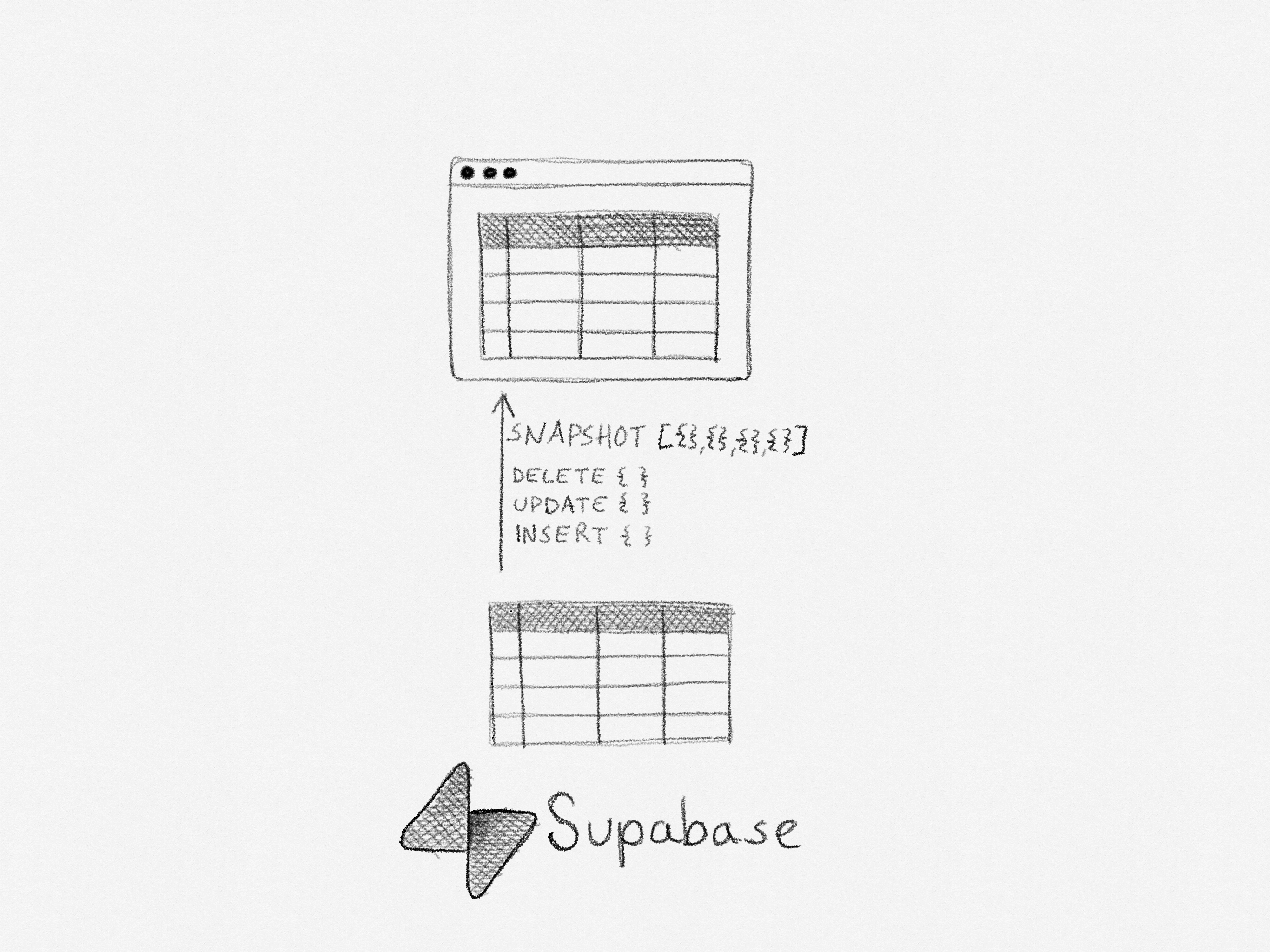@openartmarket/supabase-live-table v0.1.0
Supabase Live Table
In-memory replication of a Postgres table, synchronized with Supabase Realtime.
Motivation
Some applications need a replica of a table in memory, and keep it up to date with changes to the table in real-time. Supabase Realtime provides low-level primitives for receiving notifications of changes to a table, but it requires additional complicated logic to keep an exact replica of the table in memory.
Supabase Live Table implements this replication logic.

In the wild
- Open Art Market uses Supabase Live Table to provide a real-time order book for its art marketplace.
- Maybe your project? Send us a pull request!
Overview
Supabase Live Table provides a liveTable function that initializes the table replication.
Supabase Live Table first fetches a snapshot of the table, and then applies incremental updates to the in-memory replica. It handles edge cases of concurrent updates to the table, and guarantees that the in-memory replica stays consistent with the table.
The rows to replicate are filtered by a column value.
Installation
npm install @openartmarket/supabase-live-tableUsage
The example below shows how to replicate a table called thing with a filter column called type.
import { liveTable } from '@openartmarket/supabase-live-table'
import { SupabaseClient } from '@supabase/supabase-js'
import { Database } from './Database'
type ThingRow = Database['public']['Tables']['thing']['Row']
const channel = liveTable<ThingRow>(supabase, {
table: 'thing',
filterColumn: 'type',
filterValue: 'vehicle',
callback: (err, things) => {
if (err) {
console.error(err);
return;
}
console.log(things);
}
});Automatic reconnection has been deliberately left out of this library. If the connection is lost, the callback function will be called with an error. It's up to the application to handle reconnection. The following example describes how to do this:
function subscribe(handleThings: (things: readonly ThingRow[]) => void) {
const channel = liveTable<ThingRow>(supabase, {
table: 'thing',
filterColumn: 'type',
filterValue: 'vehicle',
callback: (err, things) => {
if (err) {
channel.unsubscribe().then(() => subscribe(handleThings));
return;
}
handleThings(things);
}
});
}
subscribe((things) => {
console.log('Updated things:', things);
});Table configuration
LiveTable requires a few changes to your database table to work correctly.
1. Required columns
The replicated table must have the following columns:
id- a primary key column that maps to a JavaScriptnumberorstring(e.g.bigintoruuid)created_at- a timestamp column with a default value ofnow()updated_at- a timestamp column that is updated automatically when a row is updated (more about this below)- An arbitrary filter column of your choice to filter what rows to replicate. It's strongly recommended to have an index on this column.
In addition to these required columns, you can have any other columns you like.
For example:
create table "thing" (
"id" uuid primary key default uuid_generate_v4(),
"created_at" timestamp with time zone not null default now(),
"updated_at" timestamp with time zone,
-- our filter column
"type" text not null,
"name" text not null
);
create unique index thing_pkey ON public.thing USING btree (id);
-- Create an index on the filter column
create index thing_type_idx ON public.thing USING btree (type);2. Update updated_at automatically
The replication algorithm requires updated_at to be updated automatically when a row is updated. This can be done with a trigger:
create extension if not exists "moddatetime" with schema "extensions";
create trigger handle_updated_at before update on "thing"
for each row execute procedure moddatetime (updated_at);With this in place, the updated_at column will be updated automatically when a row is updated.
3. Enable realtime
Make sure the replicated table has supabase_realtime publication enabled:
drop publication if exists supabase_realtime;
create publication supabase_realtime;
-- Specify the table you're enabling realtime for
alter publication supabase_realtime add table "thing";Implementation
The Change Data Capture algorithm is based on an algorithm often used in trading systems that subscribe to market data feeds.
Market data feeds typically have two different APIs - one for requesting a snapshot of the current state of the market, and another for receiving incremental updates to the market data in real-time.
In LiveTable, the snapshot is simply a SELECT query, and the incremental updates are the Supabase Realtime messages.
The algoritm is as follows:
- Subscribe to the Supabase Realtime channel for the table.
- Add incoming Realtime messages to an in-memory FIFO queue.
- Request a snapshot (
SELECT) once the Realtime channel is active. - Apply snapshot data to the in-memory replica.
- Process queued Realtime messages that were received while waiting for the snapshot. Skip messages that are older than the snapshot.
- Update the in-memory replica for every new Realtime message.
Errors
If the Realtime channel is disconnected as result of a timeout or network error, the callback function will be called with an error.
Testing
There are two test suites for this library:
- test/liveTable.test.ts integration test for the
liveTablefunction. - test/liveTableBuffering.test.ts unit tests for concurrency.
It's not possible to reliably test the concurrency of the liveTable function, so the unit tests are a best effort attempt to test the concurrency of the buffering algorithm.
The unit tests simulate various concurrency scenarios by interacting directly with the internal LiveTable class.
These tests also generate sequence diagrams that show the order of events for each scenario, as well as the final state of the in-memory replica.
Documenting a system like this is called living documentation and is a great way to keep the documentation up to date.
Related
Realtime2 by Gary Austin.
A similar library that doesn't require timestamps on the table, and applies all buffered messages to the in-memory replica, even if they are older than the snapshot.
This works as long as no messages are lost, but if messages are lost, the in-memory replica might contain older data than the snapshot.
License
MIT © Open Art Market